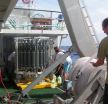(Press-News.org) The way the heart responds to an early beat is predictive of cardiac death, especially for people with no conventional markers of cardiovascular disease, according to new research from Washington University School of Medicine in St. Louis.
The conventional risk factors, such as high cholesterol, smoking, diabetes and high blood pressure, account for many but not all deaths from cardiovascular causes. As a result, doctors are always searching for better ways to identify patients at risk of cardiac death.
The new research indicates that an abnormal response to an early beat in the left ventricle, the heart's main pumping chamber, can identify high-risk patients even when they have no other evidence of cardiovascular disease.
"These are people we do not expect to die of cardiac causes," says Phyllis K. Stein, PhD, research associate professor of medicine and director of the Heart Rate Variability Laboratory at the School of Medicine. "They appear healthy, but they're not. We have shown a way they're not healthy that isn't showing up using standard tests."
The work appears Feb. 15 in the Journal of Cardiovascular Electrophysiology.
A ventricular premature beat (VPB) occurs when the ventricle gets an inappropriate signal causing it to beat before it should. VPBs are common, even in healthy people. The question is not whether VPBs occur, but how the body responds to them. The heart's response to a VPB is called heart rate turbulence. It can be measured with a Holter monitor, a device worn for 24 hours that records a person's electrocardiogram, the electrical signals produced by the heart.
When the ventricle beats early, the heart has not finished filling and it pumps less blood to the body than it should. To compensate, the heart rate speeds up to increase blood flow.
But an early beat also empties the heart early, leaving extra filling time afterward. So on the second beat after the VPB, the heart is extra full and pumps more blood to the body than it should. To compensate properly, the heart rate slows down.
A healthy heart will alternately speed up and slow down to compensate for the over- and under-filling that follows a VPB until the amount of blood filling the heart returns to normal.
Abnormal heart rate turbulence occurs when the heart can't compensate in this way.
"It's a clear test of whether the autonomic nervous system, which regulates your heart rate, can adapt to a challenge," Stein says.
Stein and colleagues analyzed Holter monitor recordings for almost 1,300 patients over age 65 recorded between 1989 and 1993.
The patients were divided into three groups based on an assessment of their cardiovascular health. Those in the "clinical" group had a history of cardiovascular disease such as heart attack or surgery to open narrow blood vessels. Those in the "subclinical" group had traditional risk factors for cardiovascular disease such as high blood pressure or diabetes but had never been treated for cardiovascular disease. And those in the "healthy" group had no evidence of clinical or subclinical disease.
In all three groups, abnormal heart rate turbulence was predictive of cardiac death. But the association was especially strong in the healthy group. Of the 357 patients classified as healthy, 21 had abnormal heart rate turbulence. These 21 people were almost eight times more likely to die of cardiac causes than the rest of the healthy group.
"Even though it's a small group of people, they're actually at very high risk," Stein says.
In fact, over the next 12 years, the people in the healthy group with abnormal heart rate turbulence had worse survival than the people with subclinical disease but good heart rate turbulence.
"They're actually not healthy," Stein says. "Something is wrong. But the conventional risk factors don't pick it up."
Stein and her colleagues also looked at levels of C-reactive protein, a measure of inflammation associated with cardiovascular disease. While C-reactive protein predicted cardiac death in the healthy group, it had no impact in the subclinical and clinical groups. Since heart rate turbulence was predictive in all three groups, it may prove better than C-reactive protein in predicting risk of cardiovascular death.
Though the Holter monitor is a common, noninvasive device, Stein says the software needed to measure heart rate turbulence is only available for clinical use on one commercial Holter monitor. She speculates that this work and other studies showing the value of measuring heart rate turbulence may make the software more widely available.
INFORMATION:
Stein PK, Barzilay JI. Relationship of abnormal heart rate turbulence and elevated CRP to cardiac mortality in low, intermediate, and high-risk older adults. Journal of Cardiovascular Electrophysiology. Feb. 15, 2011.
This work was supported by the National Heart, Lung, and Blood Institute and the National Institute of Neurological Disorders and Stroke.
Washington University School of Medicine's 2,100 employed and volunteer faculty physicians also are the medical staff of Barnes-Jewish and St. Louis Children's hospitals. The School of Medicine is one of the leading medical research, teaching and patient care institutions in the nation, currently ranked fourth in the nation by U.S. News & World Report. Through its affiliations with Barnes-Jewish and St. Louis Children's hospitals, the School of Medicine is linked to BJC HealthCare.
END
GAINESVILLE, Fla. — University of Florida researchers say their supercomputer, named Novo-G, is the world's fastest reconfigurable supercomputer and is able to perform some important science applications faster than the Chinese supercomputer touted as the world's most powerful.
In November, the TOP500 list of the world's most powerful supercomputers, for the first time ever, named the Chinese Tianhe-1A system at the National Computer Center in Tainjin, China as No. 1.
In his state of the union speech, President Barack Obama noted, "Just recently, China became home ...
Alexandria, VA – The U.S. had two key strategic advantages over the Axis in World War II: oil and water. Although other factors played major roles in the U.S. and its allies winning the war, these two natural resources played a much larger role than recognized.
World War II was the first highly mechanized war. In the March feature "How Oil and Water Helped the U.S. Win World War II," EARTH magazine explores how the abundance of domestic US oil and water in the South and Pacific Northwest drove not only tanks and planes, but also industrial production and technological ...
OAK BROOK, Ill. – Feb. 15, 2011 – Researchers from Korea report that, compared with conventional sedation, balanced propofol sedation (BPS) using propofol in combination with midazolam and meperidine, provided higher health care provider satisfaction, better patient cooperation, and similar adverse event profiles in patients undergoing therapeutic endoscopic procedures. This is the first prospective study of BPS in direct comparison with conventional sedation. The researchers note that this study provides further evidence to support the adoption of endoscopist-directed ...
Bethesda, MD - William T. Talman, MD, President of the Federation of American Societies for Experimental Biology (FASEB), praised President Barack Obama for his continuing support for science and engineering. "The President recognizes that our future depends on research," Talman stated. In a letter to President Obama, Talman noted that his "support for this critical investment—even during a time of unprecedented budgetary constraints—will help to improve the lives of millions of people."
In his FY 2012 Budget, President Obama proposed a $745 million increase over the ...
Composed of diverse elements, mostly of plastic, with little metal used, improvised explosive devices are very difficult to detect. In cooperation with two colombian universities, scientists at EPFL's Electromagnetic Compatibility Laboratory have found a solution. They have developed a device enabling the remote explosion of these mines, by using the energy from their electromagnetic impulses.
This type of mine is often used by guerillas or terrorist groups in conflict zones, and is present in many regions of the world, such as Colombia, Iraq and Afghanistan. They kill ...
MIAMI – Feb 15, 2011 – A study by scientists at the University of Miami (UM) Rosenstiel School of Marine & Atmospheric Science suggests a new way to estimate how much of the ocean's pollution is falling from the sky. The new findings can help improve scientific understanding of how toxic airborne chemicals, from the burning of fossil fuels and industrial power plants emissions, are impacting the oceans globally.
By measuring Beryllium-7 (7Be) isotope concentrations in the ocean, which is found naturally throughout Earth's atmosphere, Rosenstiel School scientists David ...
Potholes in the road or a park bench in need of repair – we all come across these or similar problems every now and then. If only there were a simple way of reporting them to the right department of the public administration! The latest mashup technology and mobile applications make it possible to come up with solutions.
Inspired by the UK website www.fixmystreet.com, the Fraunhofer Institute for Open Communication Systems FOKUS in Berlin is taking this approach further. Damage reports can be assigned GPS coordinates by cell phone and entered. The system then provides ...
You might think that a loving partner helps keep you on track—say, when you want to stick to your jogging or concentrate on your studies. But a new study in Psychological Science, a publication of the Association of Psychological Science, reports the opposite: Thinking about the support a significant other offers in pursuing goals can undermine the motivation to work toward those goals—and can increase procrastination before getting down to work.
The study's authors, psychological scientists Gráinne M. Fitzsimons of Duke University and Eli J. Finkel of Northwestern University, ...
The auto industry faces major challenges. New models are entering the market at ever shorter intervals, products are becoming more complex, and the trend towards electric cars requires modified vehicle structures. European production sites are coming under increasing cost pressure from low-wage countries. Cost reductions, shorter production times, new materials and innovative assembly techniques are needed if companies are to remain competitive. To achieve these goals, 23 business and research organizations are participating in the EU's Pegasus project (www.pegasus-eu.net). ...
Just when everyone thought that almost every plant species on the Iberian Peninsula had been discovered, Spanish researchers have discovered Taraxacum decastroi and Taraxacum lacianense, two dandelions from the Pyrenees and the Cordillera Cantábrica mountain range, respectively. This finding confirms Spain's privileged position as a hotbed of biodiversity.
"It's hard to find new species now in Spain. It depends on the complexity of the group of plants you study", Antonio Galán de Mera, lead author of the study and a researcher in the Department of Biology (Botany) at ...



